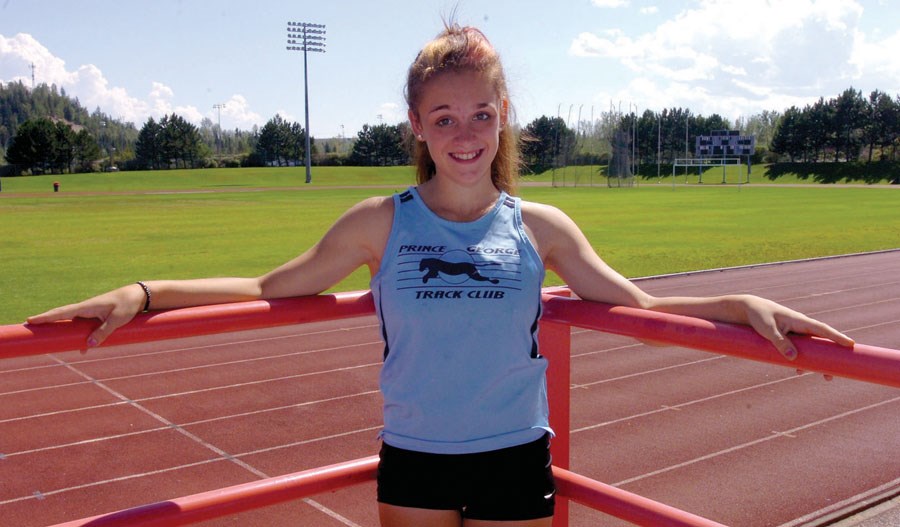Lauren Matheson won't let a curved spine derail her sprinting dreams.
The member of the Prince George Track and Field Club has had a successful season on the track, winning three gold medals and one silver medal in the 100-metre sprint and one gold, two silver and two bronze medals in the 200m distance. Thursday the 14-year-old heads to Langley to take part in the 2013 Canadian Legion Youth Track and Field Championship, Aug. 7-13, having qualified for the 100m.
Matheson accomplished all of these track feats while awaiting surgery to correct the idopathic scoliosis in her spine. Dad Rick and her PGTFC coach Kris Gaiesky first noticed the curve in her spine in August 2012.
"I was bending down in a starting position and Kris saw that I was sort of uneven," said Matheson.
She was then diagnosed by a family doctor and an orthopedic surgeon in Prince George, who referred Matheson to the BC Children's Hospital. Matheson's spine was found to be curved at a 67 degree angle on top and a 45 degree angle on the bottom. Doctors usually recommend surgery for youth with a curvature of more than 40 degrees. Matheson's surgery is tentatively scheduled for November in Vancouver.
Matheson said when she was first diagnosed she didn't even know what scoliosis was.
"I started looking things up," she said. "I just didn't really believe the things that would be happening to me. I didn't think I'd have such a bad spine.
"They don't know what [the cause] could've been, but when I looked it up online I found out it could be because one of my legs [left] is longer than the other," added Matheson.
During her online research Matheson also discovered men's 100m and 200m world-record holder Usain Bolt also has scoliosis. Another sprinter with scoliosis is Canadian Sports Hall of Fame inductee and Olympic gold medalist Bruny Surin, whose left leg is shorter than his right, which apparently gave him an edge on the corners.
"If I have a chance to get as far as [Bolt] with what I have I'd be happy," said Matheson.
Bolt holds the world and Olympic records of 9.58 seconds in the 100m and 19.19 seconds in the 200m. The women's record-holder for the 100m and 200m sprints is Florence Griffith-Joyner of the United States, who set the so far untouchable marks in July 1988 with runs of 10.49 seconds and 21.34 seconds, respectively. Griffith-Joyner, considered the "fastest woman of all time" was 28 when she set the records.
Matheson has run the 100m in 13.10 seconds and the 200m in 26.83.
There are three forms of scoliosis: congenital, idiopathic and neuromuscular. The most common form is idiopathic. The cause of it is unknown and is usually detected in adolescence after a growth spurt. It's more common in girls than boys and tends to run in families.
Angela Matheson said her daughter is the first one in their family diagnosed with scoliosis.
In many cases the scoliosis is so small people are not even aware they have it. The most common symptoms are lower back pain, back fatigue when sitting or standing for long periods of time and, in the most severe cases, difficulty breathing.
"I have to tell my teachers that sometimes I have to get up and stretch my back because the chairs are really painful for me after a bit," said Matheson. "It gets painful and I can't really do as much as the other kids in track so sometimes I have to miss out on things."
Angela said when they first saw the X-rays of her daughter's spine is was surprising.
"It was kind of shocking to see how curved it actually was," said Angela. "The surgery, it is a scary thing because it's a pretty big surgery."
The surgery will places rods inside the spine to help new bone fuse with existing bone and can correct the curvature about 50 percent, in addition to preventing further curvature.
"We just don't want her back to define who she is," said Angela. "She's always done well so she'll just keep doing what she's doing."
When Matheson won a cross-country race in Grade 3 she was instantly hooked on the sport and continued participating in school track meets before eventually joining the PGTFC when she was 10. Matheson also played on the Grade 8 girls volleyball team at College Heights secondary school last year. When she first found out about her condition, Matheson said she was worried she'd have to quit sports.
"We've never worried that she wouldn't do it," said Angela. "She's definitely got the dedication for track, but she'll just have to take some time off after the surgery."
The doctors have told the Matheson family recovery from the surgery is about one year, though after about seven to nine months Matheson should be able to return to the track. Though it means Matheson is likely out of contention for the 2014 B.C. Summer Games.
How much will Matheson miss not competing at the summer games?
"At the jamboree [in Kamloops this summer] she fell right before the finish line and her face was pretty banged up," said Angela. "She was hurting the next day but she was still back on the track and she got a bronze medal. A lot of people were pretty surprised to see her back out on the track the next day, but that just kind of shows her determination."
Matheson runs the 100m in the midget girls division at the Legion championship Friday where she's looking for a top eight finish.



